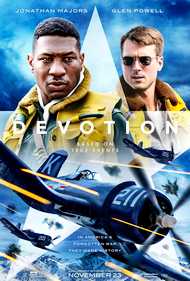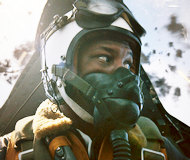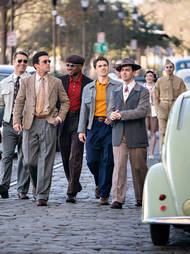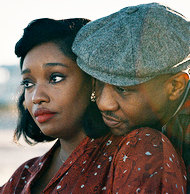Devotion
 for strong language, some war action/violence, and smoking.
for strong language, some war action/violence, and smoking.
Reviewed by: Casey Scharven
CONTRIBUTOR
| Moral Rating: | Offensive |
| Moviemaking Quality: |
|
| Primary Audience: | Adults Young-Adults |
| Genre: | War Action Drama Adaptation |
| Length: | 2 hr. 18 min. |
| Year of Release: | 2022 |
| USA Release: |
November 23, 2022 (wide release) DVD: February 28, 2023 |





Being someone that people can count on
Comrades in arms / Friendship and trust
1950s — The Korean War

U.S. Navy fighter pilots
Adaptation of Adam Makos’ book, Devotion: An Epic Story of Heroism, Friendship, and Sacrifice, which retells the comradeship between Jesse Brown and Tom Hudner during the Korean War

What is the Biblical perspective on war? Answer
War in the Bible
Armies in the Bible
Courage / bravery / self-sacrifice
PATRIOTISM—Does being a Christian mean that I should be patriotic? Answer

RACISM—What are the consequences of racial prejudice and false beliefs about the origin of different ethnicities? Answer
ORIGIN OF ETHNIC PEOPLE GROUPS—How could all ethnicities come from Noah, his three sons and their wives? Answer



| Featuring |
|---|
|
Jonathan Majors … Jesse Brown Glen Powell … Tom Hudner Christina Jackson … Daisy Brown Serinda Swan … Elizabeth Taylor Thomas Sadoski … Dick Cevoli Joseph Cross … Charlie Ward Emily Brinks … French Woman See all » |
| Director |
|
J.D. Dillard |
| Producer |
|
Black Label Media STX Entertainment See all » |
| Distributor |
“In America’s forgotten war, they made history.”
The setting for the movie is prior to the Korean War when the excitement of World War II is five years in the past. The rigors of training, training, and more training are evident on the pilots of Fighter Squadron 32 (VF-32) at Quonset Point Naval Air Station in Rhode Island, where Ensign Jesse Brown and Lt. (j.g.) Thomas Hudner first met in 1950. Brown, from Mississippi, faced the racism of the era both before and after joining the Navy, and Hudner passed on Harvard to attend the Naval Academy in Annapolis, MD. From their meeting in Rhode Island to the frozen lands of Korea during the Battle of Chosin Reservoir, the movie chronicles the relationship between Brown and his squadron mates until Brown’s death on 4 December 1950.
I was surprised the movie did not go back to show the “life stories” of the two main characters, Brown and Hudner, but thought the way the story started at one point without a lot of flashbacks worked very well. We come to learn a little about Brown and Hudner as the story progresses, but the story isn’t bogged down with flashbacks to set the tone for the “present,” and I believe it does credit to the story in this area. You know that a black man who was one of the first black Naval Aviators in the mid-1940s experienced racism; the director chose to tell the story in a powerful way by giving us a glimpse of Brown talking to himself in a mirror prior to important events where he recounted harsh words directed towards him, from childhood to his flying career—think of it as “psyching himself up.”
Jonathan Majors, who portrays Brown, shows so much emotion in these scenes, and it was well-acted. Movie-goers are given a glimpse of the pain, frustration and anger that Brown has experienced and is feeling.
Hudner comes across as “down-to-earth” and sees Brown as another flyer in the squadron and goes out of his way to get to know him and eventually meeting Brown’s wife and daughter. At the final meeting before Brown and Hudner deploy out on the USS Leyte, Hudner and Daisy Brown (Brown’s wife) have a short chat and Daisy asks Hudner to “be there for Jesse,” which Hudner agrees to
The story goes on to show the initial deployment of the USS Leyte, first to the Mediterranean Sea and then, once hostilities begin, to the Korean peninsula in a ground support capacity. The aircraft flown, the F-4U Corsair was, by Korea, a plane made to support ground troops, which requires the aircraft to fly low, putting it in range of ground-based anti-aircraft fire.
On 4 December 1950, Brown is shot down after a ground support mission and crash-lands in a field, but appears to be incapacitated and unable to exit the burning aircraft. Hudner immediately decides to crash-land his perfectly-good aircraft near Brown to extricate and protect Brown until search and rescue forces can arrive. Brown is pinned in the aircraft, and Hudner is unable to remove him. Once the search and rescue helicopter arrives (flown by a friend of Brown’s from their flight training school days), it is clear Brown is dying and Hudner is unable to save him. Hudner reluctantly leaves Brown and eventually returns to the USS Leyte, where the squadron deals with Brown’s death.
The closing of the movie is the award ceremony where President Harry Truman awards the Congressional Medal of Honor to Lt. (j.g.) Thomas Hudner for the valor and loyalty he showed his friend. The final scene is Tom Hudner telling Daisy how sorry he is that he couldn’t protect Jesse, and Daisy responds poignantly with a “that wasn’t up to you… you were there for him.”
Glen Powell’s fine performance as Tom Hudner is much different from his character in “Top Gun: Maverick” and displays his breadth as an actor.
One of the few melodramatic scenes in the movie is the announcement by the USS Leyte’s commanding officer of the death of Brown, as well as the final scene in the movie of a “Missing Man” flight formation for Daisy Brown and her daughter on the beach in Rhode Island. Both scenes departed from the realism of the overall movie into “moviemaking” for the audience.
Moviemaking Quality
As the son of an Airman and an Air Force veteran, I was engrossed in the flying scenes. Not only did they bring together surviving Bearcats and Corsairs from the 1940s and 1950s, but the aerial scenery was stunning, almost as good as the 1950’s movie “Strategic Air Command.” The carrier deck scenes are not as authentic as I would have hoped, but it does not detract from the overall production quality of the entire movie. Uniforms and camaraderie do not have any major errors, and I was pleasantly surprised by the attention to detail. The CGI is well done, although it is clear this is not a $200-million dollar big-budget summer movie; however, if you are an aviation enthusiast, you may want to purchase your ticket for the aerial cinematography alone.
LANGUAGE: I am always concerned during a military movie, as I can attest the language used away from family and friends can be rather coarse if not downright vulgar. I was pleasantly surprised at the relatively low level of vulgar and profane language in this film. Still, it is an issue (see list below).
RACISM: I do not think anyone would fail to believe there was racism in society and in the US Navy (or any service) at this time in history. This movie shows the impacts of racism on Brown and his wife in subtle ways, such as a neighbor rudely ignoring Brown one evening, and then calling in a noise complaint. There was not any overt racism against Brown within the squadron, but it was apparent in other shipboard scenes. There are a couple of scenes where the enlisted sailors (Brown was an officer) are watching Brown, and there is a short scene where the sailors gave a watch to Brown with the encouragement “we see you.”



I have read books from the era (President Truman’s autobiography is from this time) and the US was in the midst of dealing with racism in all areas of society, yet this movie shows Brown as internally dealing with the racism he had experienced (the aforementioned “psyching-up” sessions in front of a mirror). It is in these scenes the “N-word” is used on a couple of occasions, with Brown recounting the word being used towards him. The movie does not gloss over racism; it does not seem to be putting forth a “fairytale” vision without racism. It shows the impacts of racism, from Brown’s memories to the interactions with the enlisted sailors. Brown recalls water training at his flight school where he was weighted down and forced to take the test repeated as a black man can’t swim; Brown recounts the instructors did not care if he died in the pool. There are also scenes with onboard US Marines which have racist undertones, and a scene at a casino where Brown is not served alcohol at the bar. We also see Brown upset when Hudner accurately describes Brown’s disobeying of orders to return and single-handedly destroy a bridge; Hudner viewed it as a truthful statement while Brown recognized the focus would not be on the bravery of destroying the bridge but on the insubordination of the black aviator. This scene leads to a powerful scene between Brown and Hudner whereby Hudner tells Brown he is sticking his neck out for Brown and Brown strongly disagrees and asks Hudner to “get into the fight.”
CAMARADERIE: The movie is realistic to a degree on the level of camaraderie within units, which often causes people from diverse backgrounds to mold together as a single unit. Not to say there are never any scrapes, but when faced with stressful situations unit integrity can be a stabilizing force for unit members. This is depicted in the movie when a character is lost in a training accident, as well as when Brown is killed. Finally, the movie shows how the Brown and Hudner families grew close and continued to be close.
FAMILY: Brown is portrayed as a solid husband and father, with loving relationships with his wife and daughter. He and his wife show a truthful version of pre-deployment anxiety and rituals prior to the service-member’s departure and show a tender moment where his wife tells him she trusts his flying instincts.
FAITH: There is very little exhibition of Christian faith in the movie—only a prayer and a cross seen worn by one character.
SEX: Sex is not depicted in the movie, outside of the pursuit of women while on shore leave, vulgar jokes about picking up women, a kiss and use of the words “screw” and “whorehouse.”
DRUG USE: Alcohol is shown as being consumed to excess; there are no other drugs portrayed except tobacco use.
OTHER ISSUES: Gambling
Conclusion
A tough call. Who would I recommend not see this movie? Certainly, pre-teens and younger have no business going to a movie with the issues I have identified. Some adults and possibly some older teenagers may wish to see the movie, if they are aware of the issues. I appreciated the story and the aviation scenes, and well realize the military was not inhabited by choirboys in the late 1940s and early 1950s. Racism is a topic which the moviegoer must engage with, as well as the life-and-death struggle portrayed in combat situations. There are many depictions in the movie of themes familiar to Christians—friendship, family, stresses in wartime, racism, and others. I wish the film had not been so devoid of depictions of Christian faith. I always wish to enjoy the freedom God gives Christians (“So, whether you eat or drink, or whatever you do, do all to the glory of God.” —1 Corinthians 10:30-31 ESV) while also desiring to not be entertained by the sins for which Jesus Christ died. These are considerations every Christian should make when considering any enterainment, including this movie.
- Violence: Heavy
- Profane language: Heavy— • J*sus (2) • Chr*st (1) • H*ll (13) • D*mn (4) • Dear G*d (1) • G*d help us (1)
- Vulgar/Crude language: Moderate— • Sh*t (in one form or another) (6) • Basta*d (1) • Wipe your a**es (1) • A**hole (1) • Pansy a** (1) • A** (3) • Monkey a** (1) • Screw (referring to sex) (2) • A man gestures his middle finger to another man
- Nudity: Mild— • Cleavage displayed by a Hollywood celebrity
- Sex: Mild
- Drugs/Alcohol: Mild
- Occult: None
- Wokeism: None
Learn about DISCERNMENT—wisdom in making personal entertainment decisions
See list of Relevant Issues—questions-and-answers.


Moral rating: Offensive / Moviemaking quality: 5
Moral rating: Better than Average / Moviemaking quality: 5
PLEASE share your observations and insights to be posted here.



The flying scenes were equally beautiful and emotionally intense. I also loved how the film addressed more subtle, but equally internalized racism (I wish I could say “of that era”, but some of it still lingers on). When films only show more overt racism, it can come across as an exaggerated caricature of life, reduce characters to 2 dimensional “good or evil, hero or villain”, and overlook a few basic facts: people are quite complex and racism HURTS.
And showing the actions and effects of more covert racism is THE VERY definition of woke: to be aware of injustice, especially racism.
So the wokeism in this film is HIGH.
My Ratings: Moral rating: Average / Moviemaking quality: 5